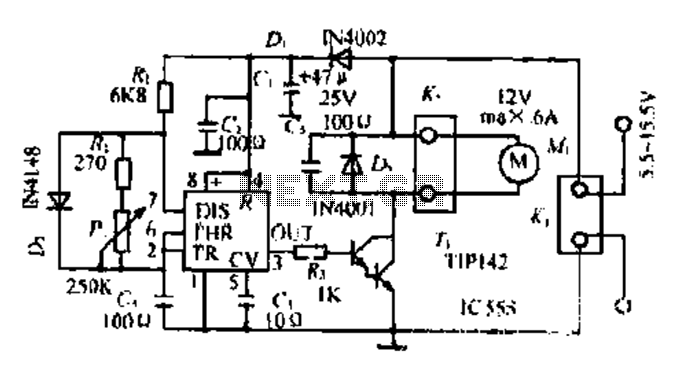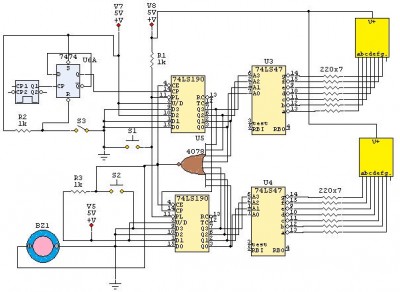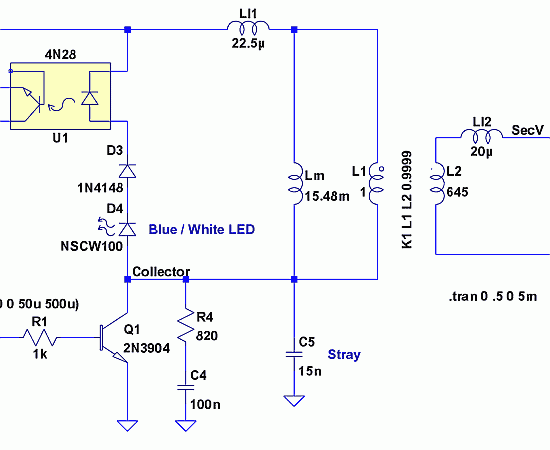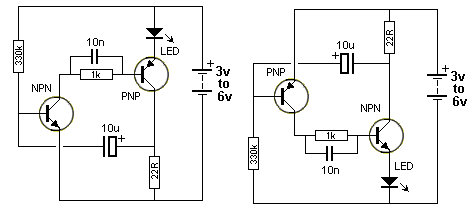
A DC motor PWM speed control circuit

Most governors utilize pulse width modulation (PWM) and pulse position modulation (PPM) in their circuits. The 555 timer is commonly used in these applications. The pulse width is typically fixed at 0.5 milliseconds, which is essential for the functioning of various motor starters. The duration of the pulses is crucial, especially when controlling electric machines. A typical setup allows for pulse durations of about 5 milliseconds, which is adequate for motor control. The frequency, determined by the resistor-capacitor (RC) network, influences the discharge time of the circuit. By adjusting the resistor values, the discharge time can be modified, impacting the revolutions per minute (RPM) of the motor. The pulse interval can vary significantly, with a range of approximately 1 to 14 milliseconds, allowing for a broad control of motor speed. If a 20kΩ thermal resistor is used in conjunction with a 12V/6A motor, the circuit can effectively manage motor operation.
Most governors in electronic circuits employ pulse width modulation (PWM) and pulse position modulation (PPM) techniques for efficient control of motor operations. The 555 timer IC is a prevalent choice for generating precise timing intervals in these applications. In standard configurations, the pulse width is set to a fixed duration of 0.5 milliseconds, which is critical for the reliable operation of various motor starters.
The pulse duration is a vital parameter, particularly when interfacing with electric machines, where a pulse width of approximately 5 milliseconds is often sufficient for effective control. The frequency of the PWM signal, which is influenced by the resistor-capacitor (RC) network within the circuit, determines the discharge time of the 555 timer. By varying the resistance values in the network, the discharge time can be adjusted, thereby affecting the revolutions per minute (RPM) of the connected motor.
The pulse interval can be manipulated to achieve a range of operational speeds, typically from 1 to 14 milliseconds. This flexibility allows for a wide spectrum of motor speed control, adapting to various application requirements. When a thermal resistor of 20kΩ is incorporated into the circuit, alongside a motor rated at 12V and 6A, the design can efficiently regulate the motor's performance, ensuring smooth operation and responsiveness to control signals. This configuration is particularly useful in applications requiring precise motor control and speed regulation.Dong Fang Zhuo most governors are pulse width modulation, pulse position modulation DA foot of the circuit (the clock when called righteous side of the system). Manifold 555 ov er-prescription contact Hajime Watanabe modulator ( lose foot mountain pulse width is fixed ff 0.5 ms (when thirty towel holder 0. I normally respect the decision). Thus, creeping pulse duration are f by the electrical machine connected to exhaust 05 ms. this is sufficient to pity, especially when the majority of motor starters, ianlwa last turn depend upon compliance pulses ask every time interval shorter shutter speed higher, this time interval err delete namely Cn by f, R.
lc, DIS to end (7 feet) discharge time. Therefore, adjusting Pi 0 change the discharge time that is r eight consecutive section built motor revolutions. then shown around the element in what number, collapse f Sh pulse interval may be as I - 14 milliseconds, therefore, Quine section motor speed range is quite wide, if installed in the L N thermal 20k /.
W of the radiator L. circuit can be controlled collapse straight 12V/6A of splashing motor.
Most governors in electronic circuits employ pulse width modulation (PWM) and pulse position modulation (PPM) techniques for efficient control of motor operations. The 555 timer IC is a prevalent choice for generating precise timing intervals in these applications. In standard configurations, the pulse width is set to a fixed duration of 0.5 milliseconds, which is critical for the reliable operation of various motor starters.
The pulse duration is a vital parameter, particularly when interfacing with electric machines, where a pulse width of approximately 5 milliseconds is often sufficient for effective control. The frequency of the PWM signal, which is influenced by the resistor-capacitor (RC) network within the circuit, determines the discharge time of the 555 timer. By varying the resistance values in the network, the discharge time can be adjusted, thereby affecting the revolutions per minute (RPM) of the connected motor.
The pulse interval can be manipulated to achieve a range of operational speeds, typically from 1 to 14 milliseconds. This flexibility allows for a wide spectrum of motor speed control, adapting to various application requirements. When a thermal resistor of 20kΩ is incorporated into the circuit, alongside a motor rated at 12V and 6A, the design can efficiently regulate the motor's performance, ensuring smooth operation and responsiveness to control signals. This configuration is particularly useful in applications requiring precise motor control and speed regulation.Dong Fang Zhuo most governors are pulse width modulation, pulse position modulation DA foot of the circuit (the clock when called righteous side of the system). Manifold 555 ov er-prescription contact Hajime Watanabe modulator ( lose foot mountain pulse width is fixed ff 0.5 ms (when thirty towel holder 0. I normally respect the decision). Thus, creeping pulse duration are f by the electrical machine connected to exhaust 05 ms. this is sufficient to pity, especially when the majority of motor starters, ianlwa last turn depend upon compliance pulses ask every time interval shorter shutter speed higher, this time interval err delete namely Cn by f, R.
lc, DIS to end (7 feet) discharge time. Therefore, adjusting Pi 0 change the discharge time that is r eight consecutive section built motor revolutions. then shown around the element in what number, collapse f Sh pulse interval may be as I - 14 milliseconds, therefore, Quine section motor speed range is quite wide, if installed in the L N thermal 20k /.
W of the radiator L. circuit can be controlled collapse straight 12V/6A of splashing motor.





